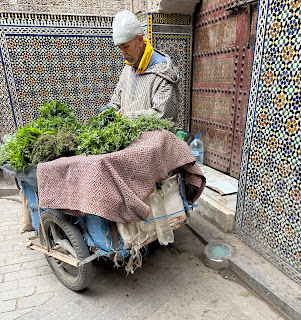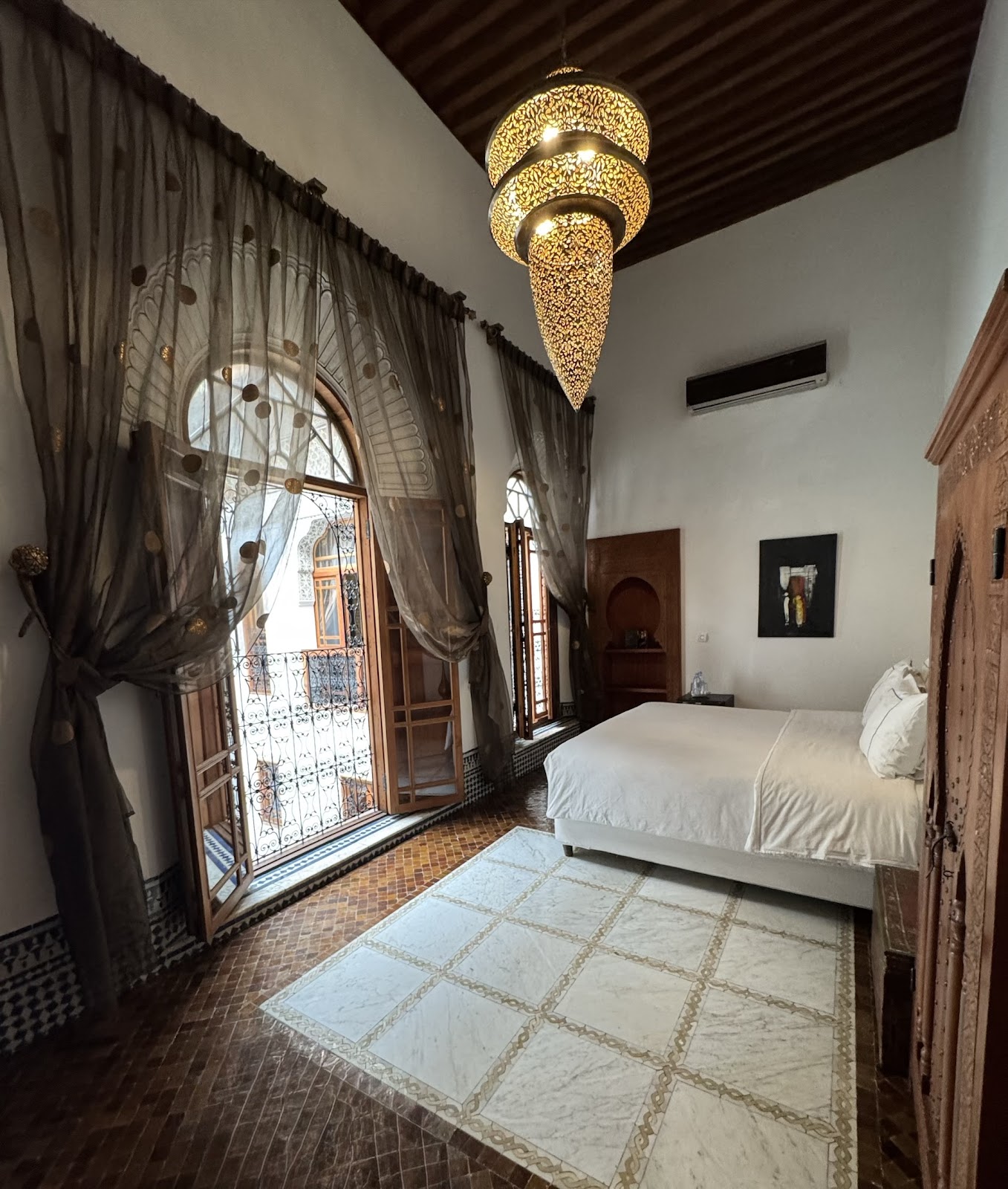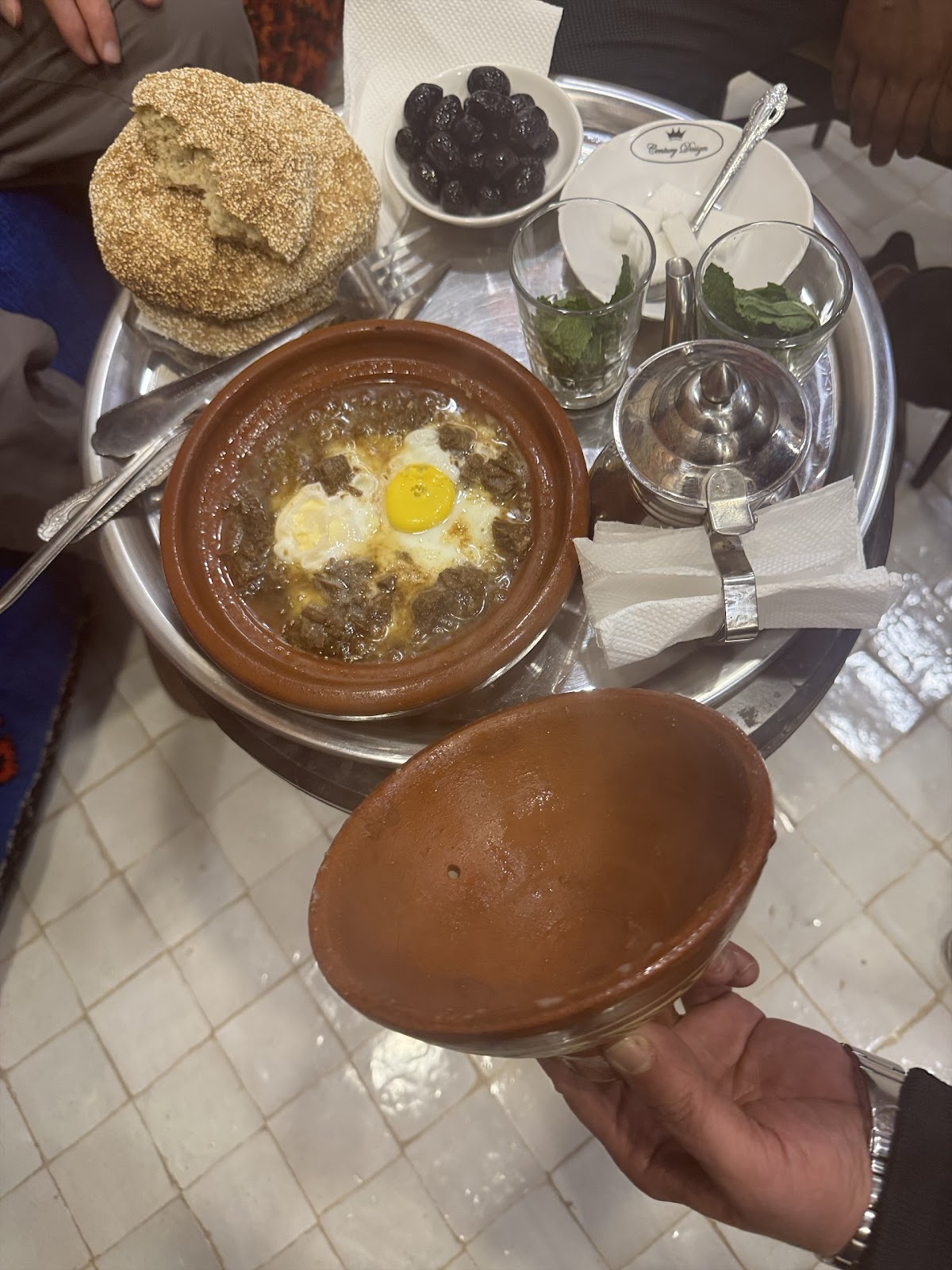 |
| Parking a donkey in the Fes medina |
The last time we were in Morocco was 15 years ago on a short hop from Madrid to Marrakech. It‘s a beautiful city filled with history, but we were hassled to the point that I didn‘t think we would ever return.
The souks overflowed with cheap reproductions of traditional Moroccan handicrafts, some made in China and almost all priced in euros for the convenience of French and Italian sunseekers. Haggling is a way of life as it is in many parts of the world. Sadly, it wasn;t always good-natured.
“You are Jewish, I can tell,” one shopkeeper called out to my husband, Tom, when we left his jewelry shop without buying (Tom is Italian-American). Another accused us of being from Texas.
 |
| The Fes medina |
Yet, here we are again, this time deep inside what some consider the best-preserved old city in the Arab world, the sprawling, labyrinthine medina of Fes el Bali. On a walk with our friend Jamal, a freelance guide whom we met on Airbnb, we encounter a donkey and its owner along one of the 9,000 “streets” - maze-like alleys really - in the 13th century walled old city.
 |
| Vendors use push carts to deliver fresh mint to tea shops |
With traffic limited to animals, pedestrians and push carts, we walk with Jamal through lanes once measured by the width of camels to souks filled with vendors working in closet-like niches. They stir vats of soup, brew tea, bake bread and shatter slabs of peanut nougat into bite-sized pieces. One section is devoted to wedding dresses. Others to metal crafts, weaving and woodcarving. Stalls overflow with tiny bottles of orange blossom oil, shiny tea pots and brightly-colored leather cushions. Bargaining is expected, but no one pressures us to buy.
 |
| Tanning and dying leather is one of the major industries in Fes |
 |
| Tea shop in the medina |
Walking through an unmarked opening in a wall, and up several steep flights of narrow stairs, we meet Abdullah, 71, and drink our first of many glasses of tea brewed with piles of fresh herbs delivered daily to the stand he has operated in the Medina for 50 years. We sit in stools while he boils the water in copper cups on a tiny stove, then pours it into tall glasses stuffed with mint, lemon verbena and orange blossoms.
 |
| Boiling hot water for fresh mint tea |
 |
| Sorting through fresh mint and other herbs delivered daily |
Lesson learned: Morocco's imperial cities of Marrakech, Fes, Meknes and Rabat- the homes of sultans and kings over the centuries - are as different from each other as Seattle, New York, Houston or Los Angeles.
Marrakech, the most well-known, is a logical first choice for most visitors, but on our second visit, we were determined to delve deeper. Several days spent in Fes, Morocco's oldest city and considered the Islamic country's spiritual capital, and then Rabat, the current capital, left us feeling immersed in an exotic culture more focused on daily life than tourism.
One of our best decisions was to forgo stays in modern hotels in the newer parts of each town in favor of staying in riads tucked inside the walled medinas. Riads are traditionally-styled multi-level guest houses with rooms facing an inner courtyard. They were formerly the homes of wealthy families and merchants until they moved to the new towns (Villes Nouvelles) built by the French. After that time, many of the riads became rooming houses for poor residents who lived in the medina. As tourism advanced in Morocco, many were turned into hotels, offering a peaceful retreat from the chaos outside.
 |
| Deliveries are made by pushcarts or donkeys in the Fes medina |
In Fes, the five-story Riad Layla became our home for the next five nights. A taxi dropped us at the nearest “gate,” or portal to the medina. Men with pushcarts wait to help people with their luggage, but since we had only roller bags, and Riad Layla wasn’t far, we walked in on our own and rang the buzzer next to a heavy wooden door.
 |
| Riad Layla's inner courtyard |
 |
| Our bedroom |
Overlooking the courtyard garden was our third-floor room, reached by climbing 30 narrow, winding steps with no handrails. Getting to breakfast each morning required going down those steps again, crossing the courtyard, and climbing another 72 steps to the fifth floor rooftop terrace. There a traditional Moroccan breakfast awaited - fresh-squeezed orange juice, coffee, tea, eggs, and assortment of savory pancakes, corn cakes and some French touches (Morocco was a French protectorate from 1912-1956) such as fresh baguette and warm croissants. Like most everything in Morocco, our riad was a bargain at around $125 per night including breakfast.
 |
| Touring the medina with Jamal |
Our second-best decision was to ignore advice to not try to navigate the Medina on our own without joining either a group tour or hiring a private guide for the entire time. Using our introductory two-hour walk with Jamal to orient ourselves, we then relied on a GPS to map and track where we were going and where we had been. Landmarks helped (turn left at the stall where the guy cuts chicken with a scissors) and hints from Jamal such recognizing the shape of street signs indicating a dead-end.
Scattered throughout the medina are mosques, museums, the world's first and still-operating university, and a massive leather tannery where visitors are given bouquets of mint to hold to their noses to mask the smell.
 |
| Making chicken sandwiches in the Fes medina |
Street food vendors, woodworkers, metal craftsmen and bakers carry on family-owned businesses that go back generations. Moroccans generally shy away from having their pictures taken, so to create some opportunities to photograph and gain a better insight into culinary traditions, we spent several hours on a street food tour one morning with Mostafa Laachaci, a guide for a local travel agency whom we found on the website Get Your Guide.
Our first stop was to a stall where the fifth-generation owners cook a high-protein breakfast soup of fava beans, olive oil and garlic on a wood-burning stove. Mostafa picked up a few rounds of barley bread to go with the soup which we ate standing while he went off to buy a few eggs, some black olives and a plastic bucket of khlea, a confit of Moroccan preserved meat.
 |
| Making fave bean soup |
Next stop was a carpet shop where Mostafa had arranged with the owners to set up a little table for us to enjoy the meal. While we talked with the owners, he went off to have the meat and eggs cooked in a traditional tagine, a cone-shaped clay pot which Moroccans use to slow-cook meat and vegetable casserole dishes.
 |
| Our street food lunch served in a carpet shop |
Street cooks start early preparing special dishes, using techniques handed down by generations of family members. Old photos in this woman's stall showed her parents or grandparents making a type of pastry dough called warqa in the exact say way she makes it today. The dough is used in a savory pie called pastilla. She rolls a ball of dough flat, then stretches it over an upturned jar that looks like a bald head that is heated underneath. The result is a thin and crispy pastry which is wrapped around the ingredients - usually chicken or vegetables - in the pastilla.
We love finding ways to connect with locals when we travel. Booking a dinner in a family home through Eatwith.com, the Airbnb of dining, is one of the best ways. A search on the website connected us with Fadila Eddaoui and Driss Mikdar who live in the Ville Nouveau, the modern town filled with high-rises, swank cafes, gardens and wide boulevards.
 |
| Avenue Hassan II in the Ville Nouveau is lined with palm trees and gardens |
A short taxi ride from the Medina took us to their flat, a spacious upper-floor apartment where Fadila teaches cooking classes when she is not teaching French at the local middle school. Driss is a tour guide, and together, they have been working on a cookbook called A Feast in Fes available on Amazon.
 |
| Fadila uncovers her special lamb tagine |
There were too many dishes on the table to count, starting with homemade dates, honey cakes and Harira soup, and moving onto to chicken Pastilla – A savory and sweet delicacy made with layers of crispy pastry, shredded chicken, almonds, cinnamon, and saffron - followed by a slow-cooked lamb tagine accompanied by a half-dozen side dishes plus tea and homemade cookies.
It was meal to remember but more importantly, people to never forget.
Next: On to Rabat
 |
| Our favorite pastime: Stopping for fresh mint tea available everywhere for $1.50 per glass |





No comments:
Post a Comment